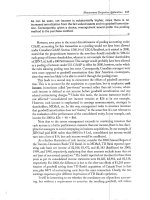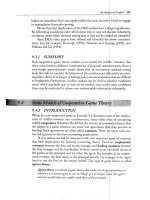Financial accounting theory 5e scot ch07
Bạn đang xem bản rút gọn của tài liệu. Xem và tải ngay bản đầy đủ của tài liệu tại đây (208.49 KB, 33 trang )
Chapter 7
Measurement Applications
Copyright © 2009 by Pearson Education Canada
7-1
Chapter 7
Measurement Applications
Copyright © 2009 by Pearson Education Canada
7-2
Two Bases of Current Value
Measurement
• Value-in-use
– Discounted present value of future receipts
– Relevance: high
– Reliability: management may change intended use
• Fair value
– Exit price: measures opportunity cost of retaining
asset/liability in firm, hence stewardship oriented
– Relevance: high if well-working market value available
– Reliability: high if well-working market value available
– Fair value is the measurement basis of SFAS 157
Copyright © 2009 by Pearson
7-3
7.2.1, 7.2.3 Longstanding
Measurement Examples
• Accounts receivable and payable
– Approximates value-in-use if time is short
• Cash flows fixed by contract
– Capital leases
– Long-term debt
• Unless interest rate changes
Copyright © 2009 by Pearson
7-4
7.2.3 Lower-of-Cost-or-Market Rule
• A partial application of measurement
– Inventory
– Ceiling tests
• A vehicle for conservative accounting
Copyright © 2009 by Pearson
7-5
7.2.4 Revaluation Option
• IAS 16
– Allows property, plant and equipment to be written up to
fair value
– Requires reasonable reliability
– Fair values must be kept up to date
– Not presently available under U.S. accounting standards
Copyright © 2009 by Pearson
7-6
7.2.5 Ceiling Test for Property, Plant
and Equipment
• IAS 36
– Applies if revaluation option not selected
– Recognize impairment loss in current earnings if book
value greater than recoverable amount
– Impairment losses can be reversed, but not to more than
book value if no impairment loss had been recorded
• SFAS 144
– 2-step procedure
• Determine if impaired (no discounting)
• If impaired, write down to fair value
• No reversal
Copyright © 2009 by Pearson
7-7
7.2.6 Post-Employment Benefits
• Pensions
– Projected benefit obligation (PBO)
• Total pension liability (discounted), including for expected
increases in compensation
– SFAS 87, 158
• SFAS 159 requires PBO, net of fair value of pension plan assets, to
be included on balance sheet
• Pension gains and losses (e.g. changes in benefits, interest rates)
included in other comprehensive income (OCI)
– Amortized into net income over time
» Continued
Copyright © 2009 by Pearson
7-8
7.2.6 Post-Employment Benefits
(continued)
• Other post-employment benefits (e.g., health
care, insurance)
– Accumulated benefit obligation (ABO)
• Similar to PBO but excluding expected increases in compensation
– SFAS 106, 158 require ABO to be included on balance
sheet
Copyright © 2009 by Pearson
7-9
7.3.1 Financial Instruments
• Definition
– A contract that creates a financial asset of one firm and
a financial liability or equity instrument of another firm
• Note broad definition of financial assets and liabilities
Copyright © 2009 by Pearson
7-
Why Fair Value Financial
Instruments?
• To increase decision usefulness
– Many financial instruments traded on well-working
markets → reasonable reliability
• To control gains trading
Copyright © 2009 by Pearson
7 - 11
7.3.2 IAS 39
• Applies to debt and equity securities
• Four financial asset categories
– Available-for-sale
• Fair valued, gains/losses in OCI
– Loans & receivables
• Valued at cost, subject to impairment test
• May be written up again if fair value rises
– Held-to-maturity
• Valued similarly to loans & receivables
– Trading
• Fair valued, gains/losses in net income
» Continued
Copyright © 2009 by Pearson
7-
7.3.2 IAS 39 (continued)
• Two financial liabilities categories
– Trading, valued at fair value
• E.g., a financial institution issues 30-day financial paper
• Accounts payable
– If longer-term, they may bear interest at a fixed rate. If so,
their fair value varies with interest rates
– Other, valued at cost
• E.g., bonds outstanding, demand deposits
» Continued
Copyright © 2009 by Pearson
7-
7.3.2 IAS 39 (continued)
• Why not simply value all financial instruments at fair
value, rather than the complex mixture of valuations
under IAS 39?
– Reliability
• Demand deposits difficult to fair value due to core deposit intangibles
• No market value may be available
– Some financial instruments thinly traded, others not traded
at all
– To control excess earnings volatility
• Unrealized gains/losses on available-for-sale included in OCI
• Loans & receivables and held-to maturity valued at cost (subject to
ceiling test)
Copyright © 2009 by Pearson
7-
7.3.4 Derivative Financial
Instruments
• Derivatives are financial instruments
• Definition
– A contract, the value of which depends on some
underlying…
– May not require an initial cash outlay
– Generally settled in cash, not in kind
• Derivatives valued at fair value under IAS 39 and
SFAS 133
– Gains and losses included in net income, except certain
hedging contracts
Copyright © 2009 by Pearson
7-
7.3.5 Hedge Accounting
• Fair Value Hedges
– Gains and losses on the hedging instrument included in
net income
• Fair valuing the hedged item offsets effect on net income
• Cash Flow Hedges
– Gains and losses on the hedging instrument included in
OCI, until the future transaction affects net income
» Continued
Copyright © 2009 by Pearson
7-
7.3.5 Hedge Accounting (continued)
• Benefits of Hedge Accounting
– Reduces earnings volatility
• Offset gains/losses by fair valuing hedged item (fair value
hedge)
• Delay gain/loss recognition by including in OCI until
realized (cash flow hedge)
• Hedging may avoid the ceiling test
– Theory in Practice 7.2
»
Copyright © 2009 by Pearson
Continued
7-
7.3.5 Hedge Accounting (continued)
• To Obtain Benefits of Hedge Accounting
– Hedges must qualify
• Must be highly effective
– Negative correlation with hedged item
– Hedges must be designated
• To reduce temptation to speculate
• Requires elaborate procedure and documentation
• Macro hedging allowed under IAS 39 to simplify
Copyright © 2009 by Pearson
7-
The Firm’s Real Volatility
• Volatility of firm’s environment
– Depends on states of nature
• Less
– Natural hedging
– Hedging with derivatives
• Equals real volatility of the firm
– As chosen by management
Copyright © 2009 by Pearson
7-
Should Financial Statements Reflect
Real Volatility?
• Seems reasonable
– Investors sensitive to risk
– Real firm risk should not be covered up?
– Fair value accounting for all assets and liabilities (including
derivatives) reflects real volatility
– Historical cost accounting hides real volatility, and can result
in little warning of financial distress & legal liability
– Partial fair value accounting (i.e., the mixed measurement
model) can overstate real volatility
• This is the problem of mismatch
Copyright © 2009 by Pearson
7-
A Mismatch Example
• Firm has long-term debt outstanding
– Accounted for at historical cost
• Firm has created a natural hedge by acquiring
interest-bearing securities
– Accounted for at fair value, changes in fair value included in
net income (e.g., available-for-sale)
» Continued
Copyright © 2009 by Pearson
7-
A Mismatch Example (continued)
• Then, changes in fair value of debt are not
included in net income, but the opposite changes
in fair value of the interest-bearing securities are
included in net income
• Net income overstates the real volatility of the
firm; that is, a mismatch
» Continued
Copyright © 2009 by Pearson
7-
A Mismatch Example (continued)
•
The fair value option
– Allows firms to voluntarily fair value assets/liabilities
– IAS 39 restricts fair value option to reducing mismatch
• In this example, firm could fair value long-term debt to eliminate
excess income volatility
– SFAS 159 does not restrict fair value option to reducing
mismatch
• Theory in Practice 7.1, re: Blackstone Group
Copyright © 2009 by Pearson
7-
Use of Fair Value Option Following a
Debt Downgrade
• Suppose that a credit downgrade reduces fair value
of a firm’s debt
– No writedown under historical cost accounting
– Firm may use fair value option to write debt down
• Results in a gain to net income. Strange?
– Presumably, this is a reason IAS 39 restricts fair value
option to mismatch situations
– But can argue the gain represents the lenders’ portion of
the loss in fair value of debt—not borne by shareholders
– SFAS 159 would allow, IAS 39 would not
Copyright © 2009 by Pearson
7-
7.4 Accounting for Intangibles
• Purchased intangibles
– Goodwill arising from an acquisition (IFRS 3, SFAS
142)
• Accounted for at cost
• No amortization
• Subject to ceiling test
– Can lead to major writedowns, e.g., JDS Uniphase,
2001 Annual Report. See Theory in Practice 7.3
– Management devices to work around goodwill and
related writedowns
• “Pro-forma income,” e.g., TD Bank, 2000 Annual Report. See
Theory in Practice 7.3
» Continued
Copyright © 2009 by Pearson
7-









